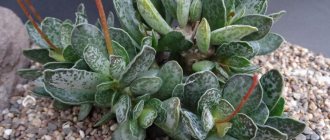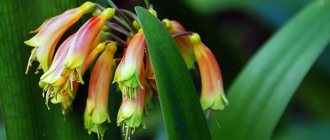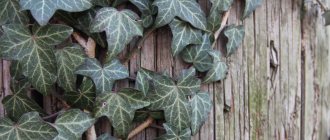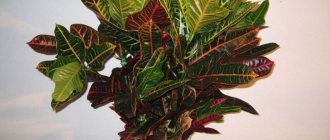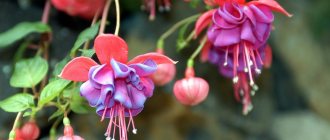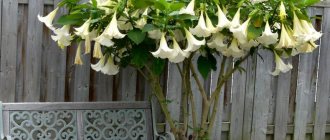Adromiscus is a plant that belongs to the Crassulaceae family. It is a succulent that is just gaining popularity. The reason is that this grass complements the interior well. Looks great both in a cozy apartment and in the office.
Author of the article
Maxim Sverchkov
Professional biologist and breeder with extensive experience and experience.
Description of the plant
Adromiscus is a favorite among gardeners. They are attracted to perennial leaves. And to be more precise, their shape and shade. They are triangular. They can be either green or bright red.
They are quite easy to care for. Therefore, owners can only admire their unusual beauty. Translated from Greek, “adromiscus” means “thick stem.” The height of Adromiscus reaches fifteen centimeters. It was first found in Africa. At the moment, you can meet him both in the south and southwest of this continent.
Overview of popular varieties
Below is a review with descriptions and photos of Adromiscus. The species considered are especially popular among flower growers.
Adromiscus crested. The plant forms erect young shoots. As they grow, they sag and become creeping. The stems are covered with aerial roots of a reddish hue. The leaf blade with a short petiole is pubescent and convex. A rosette is formed from dark green leaves. The buds are greenish-white with a pink border.
Comb
Cooper's Adromiscus. Has a compact size. Characterized by the presence of a short branching stem. The shape of the green glossy leaves is oval with a wavy edge. The plate is covered with brownish spots. The outline of the inflorescence resembles a spike. The tubular flowers with greenish-red petals are edged with pink or purple stripes.
Cooper
Adromiscus Poellnitz. Succulent with miniature dimensions (maximum 10 cm in height). Demonstrates the development of shoots branching at the base. The plant forms leaves with a convex, smooth surface at the bottom, a wide, thickened at the top, wavy edge. The length of the inflorescence with inconspicuous flowers can reach 40 cm.
Poelnitz
The beautiful adromiscus plant will bring a touch of originality to the room, making the interior more stylish and sophisticated.
What variety of adromiscus do you like?
Adromiscus species
There are quite a few different types. The data is different. While some scientists count fifty species, others talk about seventy. The difference is as much as twenty species.
Only a small part has been cultivated. Before purchasing this perennial plant, you need to carefully study all the characteristics and decide which type is best for you.
The most popular types will be discussed here.
Adromiscus Cooper
This grass is very small in size. Its foliage is a dark green shade. Large brown spots can be seen. If you properly care for the plant, its leaves will be glossy. At the same time, they will be quite smooth to the touch. The edge is usually uneven. Length no more than five centimeters. During the flowering period, flowers appear, the maximum size of which reaches one and a half centimeters. They have 5 petals. All are adjacent to the peduncle. It is long and thick.
Adromiscus Poelnitz
It reaches ten centimeters in height. This is a branched succulent. Each of the leaves looks like a geometric figure - an inverted triangle. If you look closely, you will notice that there are fibers at the edge of almost every leaf. During flowering, very large inflorescences appear. The length of each reaches forty centimeters. Small flowers are formed from the inflorescences. They are white or green in color.
Adromiscus schuldianus
They differ from other representatives in the color of their leaves. They are green, however, the closer to the edge, the more red they become. Their shape is ovoid - that is, similar to an egg. The edge of each leaf is pointed. A photo of Adromiscus will show how unusual this plant is.
Adromiscus spotted
The stem of this succulent is more stable than that of other representatives of this family. Grows up to ten centimeters in height. The foliage is round in shape. On the greenery you can distinguish spots of purple or red. The width of each leaf reaches three centimeters, and the length – five. The flowers that appear during the flowering period are a spike. Their borders are usually dark red.
Adromiscus tripeculi
The length varies from eight to ten centimeters. Unlike the stems, which are short, the leaves grow quite elongated. They have sharp edges. On a green background you can see burgundy spots. The width of the leaf varies from three to four centimeters, and the length - from four to five.
Adromiscus cristatus
The second name of this perennial plant is Adromiscus comb. It is slightly larger than Adromiscus tripistillate. It reaches fifteen centimeters in height. A distinctive feature of the succulent is the wavy edge of the leaves. The shape of the sheets is similar to inverted triangles, each of which is a light green shade. If you look closely, you can see that each plant has white fibers. The length of the leaves varies from two to five centimeters, and the width reaches two and a half centimeters. The flowers are a regular white shade. They differ from the flowers of other members of this family. After all, there is a barely noticeable pink stripe along the edge.
What's interesting about Andromiscus?
Adromiscus is a herbaceous perennial subshrub type up to 15 cm high. The plant has a creeping root and a thick lodging stem covered with aerial roots of a terracotta hue. Through them, the succulent absorbs moisture and nutritional components from the air. The root system of Adromiscus consists of many fine hairs, so they require careful treatment during transplantation. Outwardly distinctive foliage grows from a short stem - round or triangular in shape, fleshy, uniform green in color or with dark inclusions. The average width of the leaf plate is 5–6 cm with a thickness of 1 cm.
When flowering, Adromiscus shoots out a long arrow, at the top of which white and pink inflorescences bloom
Adromiscus blooms in the summer with spectacular tubular inflorescences of white and pink tones, grouped into spike-shaped racemes. They are mounted on long and strong peduncles.
Plant propagation
This perennial plant reproduces using vegetative organs.
The vegetative method is quite simple. All you need to do is carefully cut off the leaves of the adroiscus. And then leave them for a couple of hours in a dry place. At this time, you can prepare the substrate. If you have all the necessary materials, then you can create soil at home.
To do this, you need to take one part of river sand, add the same amount of peat and add the same amount of vermiculite. If there are no ingredients, then you need to purchase a mixture in the store that is intended for succulents. Once everything is ready, the leaves can be planted.
The root system will begin to develop in about four weeks.
The pot in which the adromiscus is located should be quite spacious. As soon as it becomes noticeable that the succulent does not have enough space, it must be transplanted into a new container. Just like the planting process, transplantation is carried out in the spring. You need to be very careful with this procedure, because the plant has quite fragile roots. It is important not to damage them.
Before replanting, you need to lay drainage at the bottom of the new container, then pour out the prepared mixture and only then replant the adromiscus.
There is a risk of rotting. To prevent the appearance of rot, the perennial does not need to be deepened when planting.
Reproduction of Adromiscus at home
How to propagate Adromiscus from cuttings photo
In indoor conditions, Adromiscus is propagated vegetatively:
- In late spring or early summer, separate the leaf cuttings from the bush.
- Wait until the cut area is covered with a film and plant it in the soil - clean, damp sand or vermiculite, you can root it in a universal substrate for succulents with the addition of coarse sand.
- Maintain diffused lighting and air temperature in the range of 20-22 °C, water moderately, and protect from drafts.
- After about a month, the seedling will begin to grow and can be transferred to a pot with a diameter of 5-7 cm with soil, as for an adult adromiscus.
Adromiscus care
This plant does not have strict care requirements, so caring for Adromiscus is not that difficult. Firstly, it requires constant lighting. In this case, you must carefully ensure that the leaves do not fall into direct sunlight. After all, burns can form.
The temperature in the room should be thirty degrees. In cold weather the temperature can drop to ten degrees. If the temperature is lower, the plant will most likely die.
Adromiscus does not really like spraying. Water can cause rot. It will also increase the risk of burns on the leaves. If there are damaged parts, they must be removed immediately.
Problems when growing Adromiscus
This is a strong plant that is resistant to various pests and diseases of Adromiscus. However, in some cases, you can see, for example, spider mites on the leaves. You can first walk over the leaves with a damp cloth. However, the best control method is the use of insecticides.
If the leaves are cracked, this means that you need to reduce the dose of watering. If you don't do this soon, the roots will begin to rot.
Another article described: Agave
Diseases and pests of Adromiscus
Adromischus succulent can be attacked by aphids, spider mites, and mealybugs. It is recommended to control pests with the help of special preparations. Also possible problems during cultivation are:
- yellowing and dying of the lower leaves, this process is natural for the aging of the flower;
- the occurrence of rot, this happens if liquid gets on the rosette of leaves;
- drying and yellowing of leaves - this occurs due to overwatering, burns;
- cracking of leaf plates is the result of severe drying out of the soil.
If the shoots are strongly stretched, or if the leaves are loose or faded, the lighting of the succulent should be adjusted.
